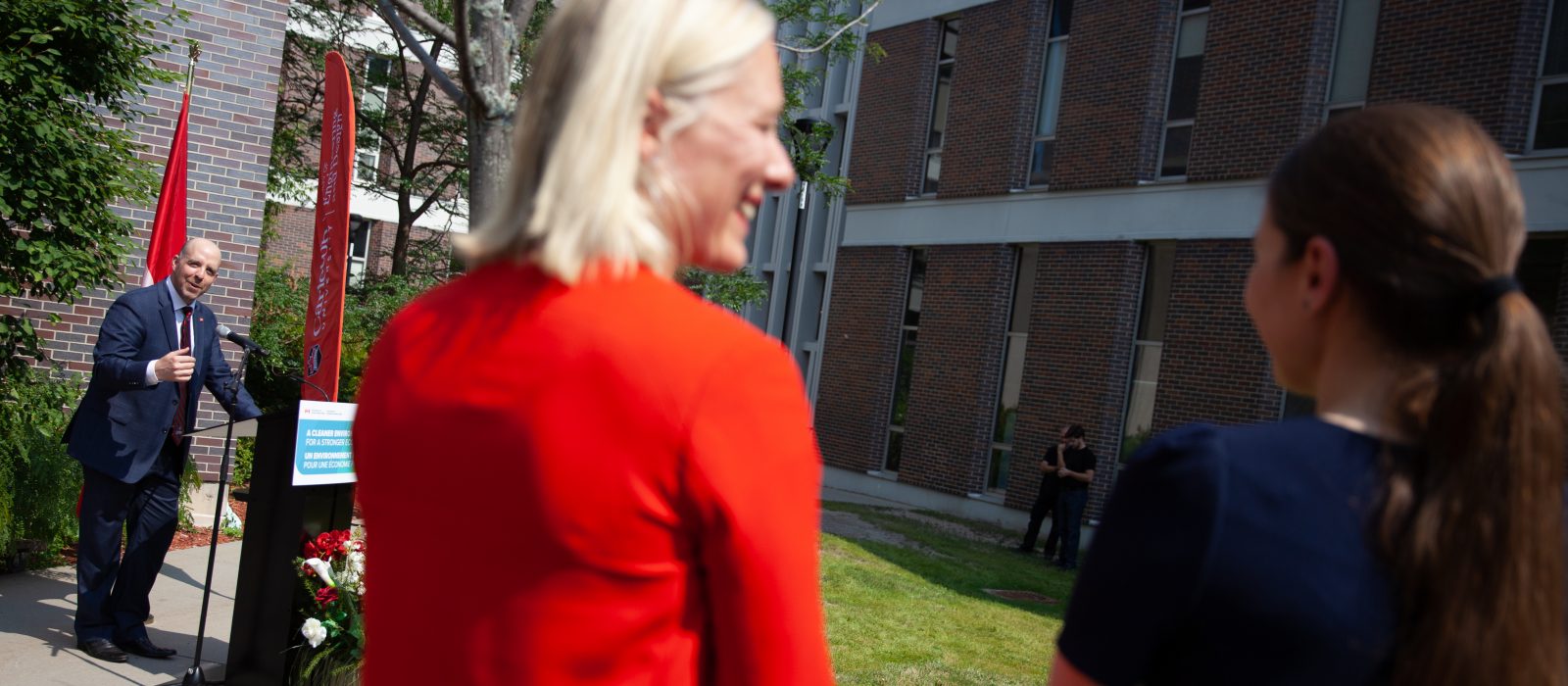
Tyrone Burke, July 31, 2019
Photo credit: Fangliang Xu, Luther Caverly
Inside the box: Carleton receives funding for two new projects looking at increasing the energy efficiency of the buildings we live and work in

In a land of frigid winter nights and steamy summer days, buildings are our shelter. They keep us warm — and cool. But they use a whole lot of energy doing it. Carleton’s new Centre for Advanced Building Envelope Research (CU-CABER) is working on ways to make them more efficient.

Led by Associate Professor of Mechanical and Aerospace Engineering Cynthia Cruickshank, CU-CABER is a six-year, $5.1M initiative supported by Natural Resources Canada’s Energy Innovation Program ($3M) and the Ontario Research Fund ($2.1M).
Reassessing how we construct buildings
A building envelope is the part that shields us from the elements. It’s a catch-all term, and can include walls, roofs, and windows. CU-CABER will develop and evaluate new envelope technologies, and provide hands-on training opportunities for students at the collegiate, undergraduate and post-graduate levels.
There are considerable gains to be made.

Residential and commercial buildings account for more than 20% of Canada’s greenhouse gas emissions. Most of that energy is used for space heating, and much of it is lost when inefficient building envelopes allow heat to escape.
“Better building envelopes promise to make our homes, schools and places of work more comfortable, durable, and resilient,” Cruickshank says.

“Improved insulation and air sealing reduces drafts, protects against condensation, and discourages mould and rot. Homes and buildings that require less energy for space heating are less reliant on utilities and are more resilient during extreme weather. Building envelope products, practices and regulations have significantly improved over the last three decades. However, Canada now faces pressing energy, environmental and infrastructure challenges that necessitate new building envelope research.”
But better products aren’t the only way that the energy efficiency of Canada’s buildings can be improved. There are also gains to be made in improving the way that buildings are managed, and Burak Gunay is working to do exactly that.
Data analysis is an important part of efficiency

“Today’s buildings — especially large commercial and institutional buildings — have thousands of sensors and actuators,” says Gunay, an Assistant Professor of Building Science in Carleton’s Department of Civil and Environmental Engineering.
“The only way they can operate properly is if all systems work in harmony. But it’s very common to see systems fail. Sometimes, they aren’t installed properly, and sometimes they are not programmed to operate optimally.”
Because of the sheer volume of systems, facilities management teams often don’t even realize there’s a problem.
But Gunay is developing an open source software platform that will help building managers identify these issues. Along with his colleagues Liam O’Brien and Scott Bucking, Gunay was awarded $510,000 through Natural Resources Canada’s Green Infrastructure Fund for his research project The Next Generation: Actionable Building Energy Performance Metrics, Data Analytics and Visualization.

The researchers are partnering with CopperTree Analytics, Delta Controls, and Sensible Building Science, and BentallGreenOak will develop a suite of diagnostic algorithms and methods to help facility managers pinpoint problems, and solve them.
These can be deceptively simple.
“Sometimes a fan starts running on forever,” Gunay says, “but if your facility has a thousand fans, you may not detect that one of them has failed. That can waste lot of energy.”
When it comes to commercial and institutional buildings, little fixes can yield big results.
“One 18-year-old student who worked with us on a controls program during the summer discovered a tiny mistake in controls programming. Fixing that mistake now saves $5,000 a year in operating costs.”
Cruickshank, Gunay, O’Brien and Bucking are all associated with the Building Performance Research Centre. It’s one of key clusters of research in to sustainability and energy efficiency that’s making for a greener Carleton — and a greener Canada.

Measuring the impact
“We’ve reduced our own emissions by 35% and are on our way toward carbon neutrality,” says Carleton University President and Vice-Chancellor Benoit-Antoine Bacon. “Natural Resources Canada’s support for Carleton University research in to sustainability and energy efficiency will enable research in to building technologies and data mining tools that will help to improve building energy efficiency. And that’s such a big part of our energy consumption and our greenhouse gas emissions.”
Canada’s Minister for Environment and Climate Change Catherine McKenna was also on hand to make the announcement. “We need to figure out emissions from buildings and houses,” McKenna said. “Cutting-edge software can help building managers monitor energy use and find ways to increase efficiency. With big data and AI we can do a lot better, and I’m very excited that’s happening right here. This research will help us build in net-zero, and that’s what we should always be building.”

Share: Twitter, Facebook